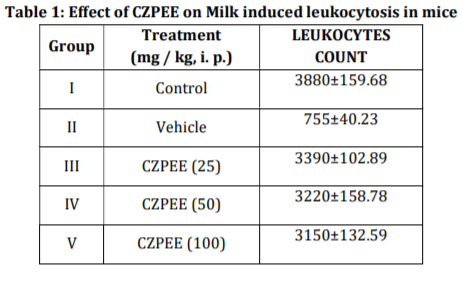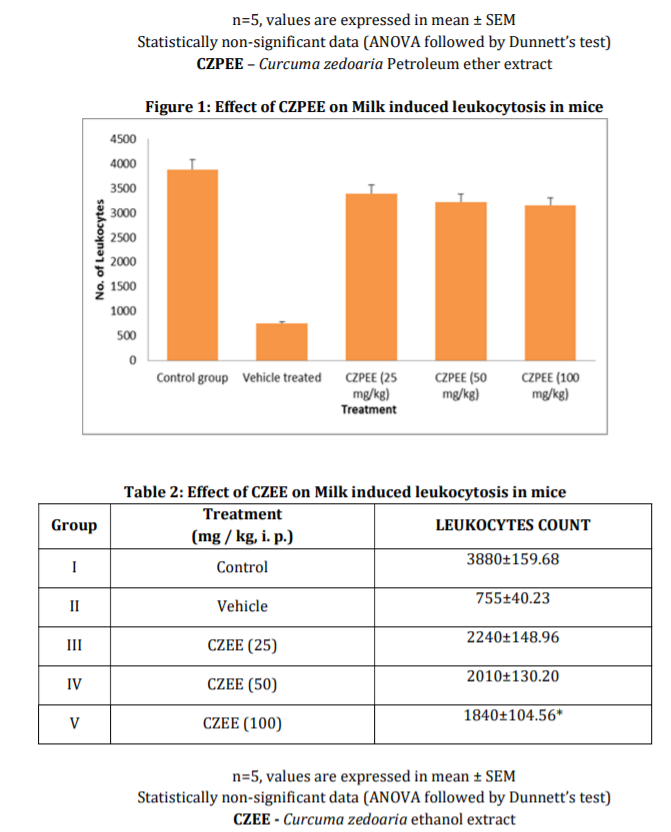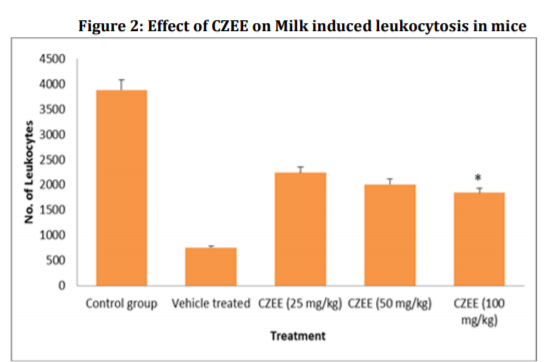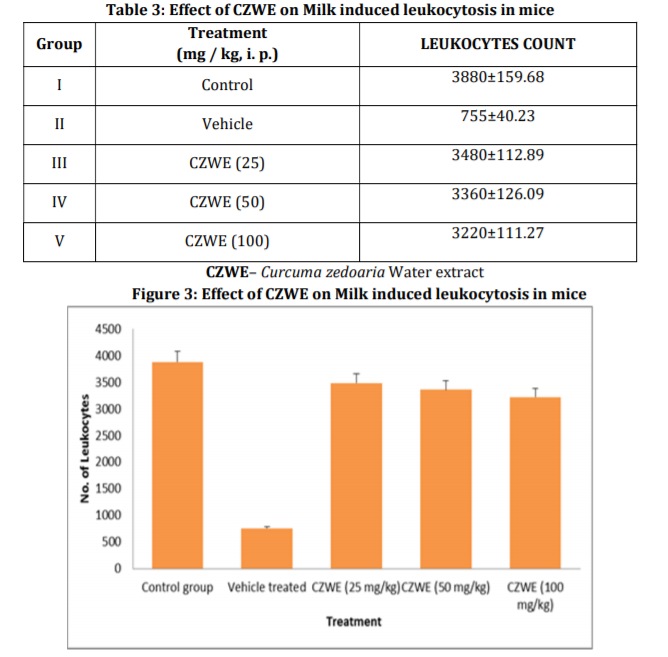Department of Botany, Calicut University, Kerala 673635, India.
Aim of study:Curcuma zedoaria (Family: Zingiberaceae) is being used in traditional medicine for the treatment of severe bronchitis and asthma. The aim of study was to evaluate antiasthmatic activity of various extracts of curcuma zedoaria rhizomes to validate its traditional use. Materials and methodsIn the present study petroleum ether, ethanol and water extract of Curcuma zedoaria rhizomes at the doses of 25, 50 and 100 mg/kg i. p. was evaluated for antiasthmatic activity using milk induced leukocytosis in mice. Results:The results of present investigation showed that the ethanol extract of Curcuma zedoaria rhizomes at (100 mg/kg, i. p.) significantly decreases milk induced leukocytosis (1840±104.56) in mice in a dose dependent manner as compared to petroleum ether and water extracts and control group. Conclusion:It can be concluded that the ethanol extract of Curcuma zedoaria (CZEE) may be used in management of asthma.
Keywords:Curcuma zedoaria, Asthma, leukocytosis
The Global Strategy for Asthma Management and Prevention Guidelines define Asthma as ‘a chronic inflammatory disorder of the airways associated with increased airway hyper-responsiveness, recurrent episodes of wheezing, breathlessness, chest tightness, and coughing, particularly at night/early morning’. Airway inflammation produces airflow limitation through acute bronchoconstriction, chronic mucus plug formation and airway wall swelling or remodeling.[1] Asthma comprises a range of heterogeneous phenotypes that differ in presentation, etiology and pathophysiology. The risk factors for each recognized phenotype of Asthma include genetic, environmental and host factors.[2] The conceptual framework for susceptibility factors of Asthma is presented below. Current understanding of the determinants of Asthma have largely been informed through the role of environmental exposures, such as exposure to aeroallergens, indoor and outdoor air pollution, endotoxin, smoking and viral infections.[3] The different ways in which tobacco smoke affects asthma. More recently, this knowledge base has been supplemented by considering genetic modifiers of environmental exposures on Asthma expression.[4,5] Meanwhile, like most diseases, Asthma also is socially patterned, with lower socio-economic groups, on average, being more burdened.[6] Some suggest that the observed social patterning in Asthma may simply reflect the disproportionate exposure to adverse environmental factors among lower socio-economic groups. [7,8] The identity of Curcuma zedoaria (Christm) Roscoe and its nomenclatural history are explained. Roscoe wrongly interpreted the basionym of this name and applied his combination to a different taxon, which is not even involved in Christmann’s protologue. The first lectotypification applied the name to the species upon which Rheede’s description of Kua was based. Study of living material reveals that the name C. zedoaria (Christm.) Roscoe is currently applied to several superficially similar taxa in different parts of India and SE Asia and there are no grounds to propose conservation of the name with a different type. To avoid more confusion, the identity of the plant representing C. zedoaria in the sense lectotypified by Burtt (1977) is explained here and a colour plate depicting its morphology is provided. The plant described and depicted by Roxburgh as Curcuma zerumbet Roxb., a name usually cited among synonyms of C. zedoaria (Christm.) Roscoe, is found to represent the taxon that Roscoe had in mind while publishing his combination C. zedoaria (Christm.) Roscoe. Curcuma zerumbet Roxb. is illegitimate however, and as there is no other name available for this taxon it is described here as Curcuma picta. The nomenclatural history of Amomum zerumbet J. König nom. illeg. and Erndlia subpersonata Giseke, names which are involved in the illegitimacy of C. zerumbet Roxb., is explained.[9]
Plant material
Rhizomes of Curcuma caesia were collected in Feb 2012, from Botanical Garden (Zinger Villa) Calicut University, Calicut (Kerala, India), and the plant was authenticated by Professor Dr. M. Sabu, Head, Department of Botany, Calicut University, Calicut (Kerala, India). A voucher specimen (PAR 14) was deposited in the herbarium for further use.
Extraction
Dried and coarsely powder of Curcuma caesia rhizomes (100 g) was defatted with petroleum ether and the marc remaining was extracted successively by petroleum ether, ethanol and water in different Soxhlet extractor. Solvent was evaporated in rotary evaporator under reduced pressure.
Animals
Swiss albino mice of either sex weighing (25-30 g) were housed under standard laboratory condition of temperature (25 ± 2°C) and 12/12 h light/dark cycle. The animals had free access to food and water. The Animal Ethical Committee of the Institute approved all the protocols of the study.
Drugs and Chemicals
5% polyethylene glycol (PEG-400), saline solution, buffer medium, Sodium chromoglycate, RPMI-1640 were purchased from Himedia, India. Clonidine (Alembic), petroleum ether (60-80°C), ethanol (95%). All Chemical and reagents were of analytical grade.
Acute toxicity study
Acute oral toxicity study was performed as per OECD 423 guideline. Extract was administered up to the maximum dose of 2000 mg/kg and animals were observed for mortality.[10]
Milk induced leukocytosis in mice
Mice were divided into five groups, five animals in each group. Animals belonging to Group-I serve as control and treated with vehicle 1ml /kg, i. p. and boiled and cooled milk in a dose of 4 ml /kg, s. c. Animals belonging to Group II received only vehicle (5 % PEG-400, 1ml / kg, i. p.). Animals belonging to Group III, IV and V were received test extracts in a dose of (25, 50,100 mg / kg, i.p.) respectively, 1 hr before milk injection. Blood samples were collected from each mouse from retro-orbital plexus under light ether anesthesia. Total leukocyte count was done in each group before drug administration and 24 hr after milk injection. Blood was sucked in WBC pipette up to mark and further diluted with WBC diluting fluid. Pipette was shaken for few seconds and kept aside for five min. Neubaur’s chamber was charged with above fluid and Total Leukocyte Count was done. Difference in Total leukocytes count before and 24 hr drug administration was calculated.[11]
Statistical analysis
The data were presented as mean ± Standard error mean. The statistical significance between the groups has been tested by analysis of variance followed by Dunnett’s test. A P < 0.05 were considered as significant.




Acute toxicity test
The LD50 value of Curcuma caesia rhizome extracts when given intraperitoneally and tested in albino mice was found to be more than 2000 mg/kg body weight.
Milk Induced Leukocytosis in mice
Ethanol extract of rhizomes of Curcuma zedoaria shown statistical significance at dose of 100 mg/kg and positive inhibition was seen with leukocyte count 1840±104.56. Petroleum ether and water extract unable to produce the same inhibition of significance. Ethanol extract of rhizomes of Curcuma zedoaria (CZEE) antagonizing the leukocytosis as shown in table 2 and figure 2.
Our previous study indicates that Curcuma caesia ethanolic extract produce significant inhibition in leukocytosis and eosinophil count. [12,13] In the present investigation Curcuma zedoaria rhizome extracts at doses of (25, 50 and 100 mg/ kg, i. p.) was evaluated for management of asthma using milk induced leukocytosis. Pretreatment with Curcuma zedoaria rhizomes petroleum ether, ethanol, and water extract at all three doses screened for the inhibition of leukocytosis. Only ethanol extract significantly (p<0.05) at 100 mg/ kg i. p was able to inhibit the leukocytosis (1840±104.56). CZEE decreases leukocytes count by normalizing oxidative stress and/or adaptogenic activity, and decrease in eosinophil may reduce type I hypersensitivity in asthma. In conclusion, Curcuma zedoaria ethanol extract is found to be effective in the management of asthma.
The result of this parameter lent support to the indigenous use of Curcuma zedoaria in the treatment of some of the aspects of allergic bronchial asthma as adaptogenics/ antistress agents.
References
- 1.Masoli M, et al. Global Initiative for Asthma (GINA) program: the global burden of asthma: executive summary of the GINA Dissemination Committee report. Allergy 2004; 59:469-478. [Google Scholar] [Google Scholar] [PubMed]
- 2.Burke W, Fesinmeyer M, Reed K, et al. Family history as a predictor of asthma risk. Am J Prev Med 2003; 24:160-169. [Google Scholar] [Google Scholar] [PubMed]
- 3.Maddox L, Schwartz DA. The pathophysiology of asthma. Annu Rev Med 2002; 53:477–98. [Google Scholar] [Google Scholar] [PubMed]
- 4.Kleeberger SR, Peden D. Gene-environment interactions in asthma and other respiratory diseases. Annu Rev Med 2005; 56:383–400. [Google Scholar] [Google Scholar] [PubMed]
- 5.Weiss ST. Gene by environment interactions and asthma. Clin Exp Allergy 1999; 29(suppl 2):96–99. [Google Scholar] [Google Scholar] [PubMed]
- 6.Wright RJ, Fisher EB. Putting asthma into context: community influences on risk, behavior, and intervention. In: Kawachi I, Berkman LF (eds). Neighborhoods and Health. New York: Oxford University Press, 2003. [Google Scholar] [Google Scholar] [PubMed]
- 7.O‘Neill MS, Jerrett M, Kawachi I et al. Health, wealth and air pollution: advancing theory and methods. Environ Health Perspect 2003; 111:1861–70. [Google Scholar] [Google Scholar] [PubMed]
- 8.Weiss KB, Wagener DK. Changing patterns of asthma mortality: identifying target populations at high risk. J Am Med Assoc 1990; 264:1683–87. [Google Scholar] [Google Scholar] [PubMed]
- 9.Skornickova, J. L, O. Sida, M. Sabu, K. Marhold. 2008. Taxonomical and Nomenclatural puzzles in Indian Curcuma: The identity and Nomenclatural history of C. zedoaria (Christm.) Roscoe.and C. zerumbet Roxb. (Zingiberaceae). Taxon 57(3): 949-962. [Google Scholar] [Google Scholar] [PubMed]
- 10.Organization of Economic Co-operation and Development (OECD). The OECD Guidelines for Testing of Chemical: 423 Acute Oral Toxicity, France, 2001 [Google Scholar] [Google Scholar] [PubMed]
- 11.Bhargava KP, Singh N. Anti-stress activity of Ocimum sanctum. Indian J Med Res, 73: 443-445, 1981. [Google Scholar] [Google Scholar] [PubMed]
- 12.Aslam Ramjan Pathan. Pharmacological Investigation of Curcuma caesia in Management of Asthma. Inventi Rapid: Ethnopharmacology, 2014(4):1-4, 2014. [Google Scholar] [Google Scholar] [PubMed]
- 13.Aslam Ramjan Pathan. Pharmacological Investigation of Curcuma caesia in Management of Asthma. Inventi Rapid: Ethnopharmacology, 2014(4):1-4, 2014. [Google Scholar] [Google Scholar] [PubMed]

